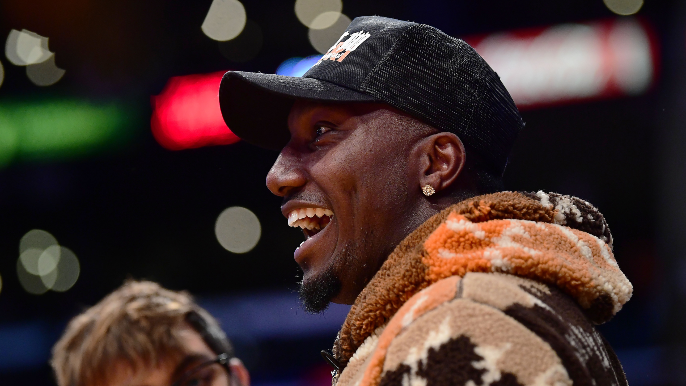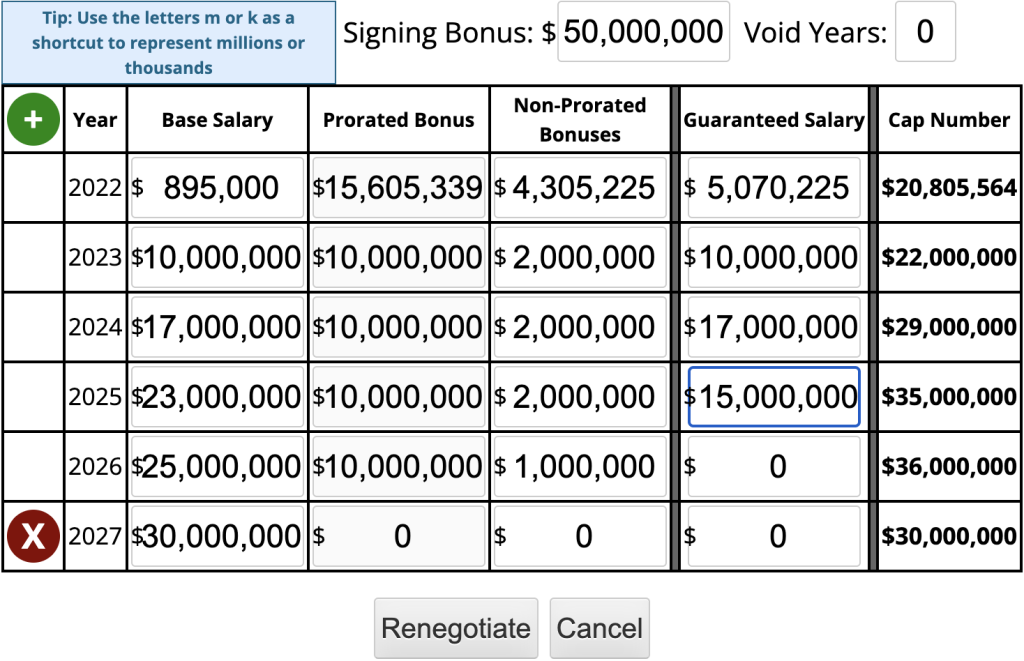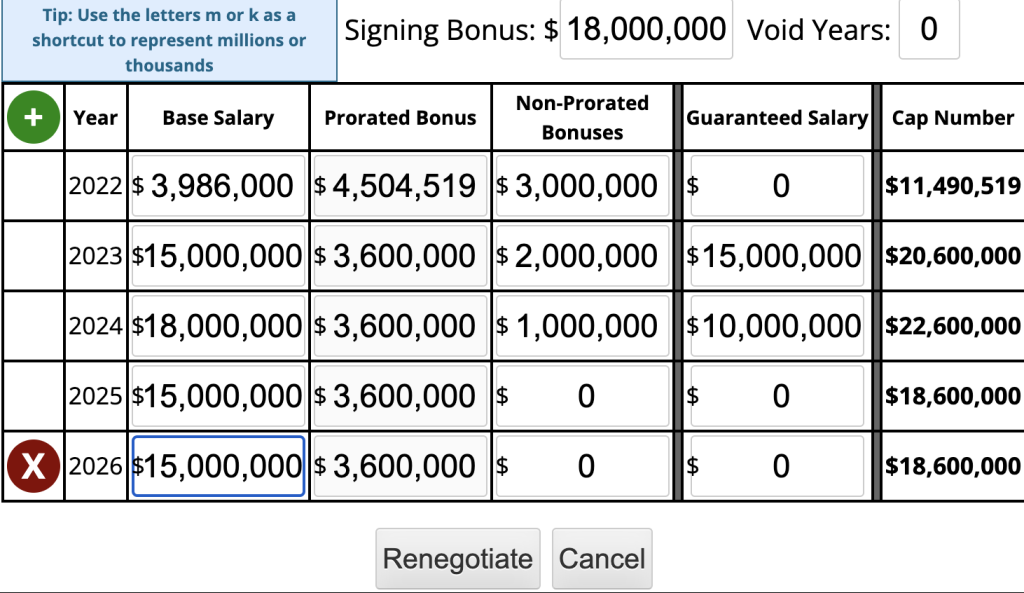
In one month, the NFL free agency window will swing open, and the new league year will begin. At that point, the 49ers can trade Jimmy Garoppolo, and start setting up their roster for next season.
With that defining trade on the horizon, some mega extensions looming, and a handful of key, expiring contracts, the 49ers have some monumental decisions to make. Here’s a look at those decisions and what’s at play.
Jimmy Garoppolo trade
While the 49ers will lament the fact that the season ended with a loss to the Rams, and a potential, if not likely Super Bowl victory, going that far in the playoffs made the season a success, and ensured Jimmy Garoppolo kept some value on the market.
How much he will fetch in a trade will depend on the other major quarterbacks who could move, like Aaron Rodgers, Russell Wilson, Deshaun Watson, Derek Carr, maybe even Kyler Murray.
There have been three clear favorites to land Garoppolo in the Washington Commanders, Tampa Bay Buccaneers and Pittsburgh Steelers. But there are reports that the Indianapolis Colts are likely to move on from Carson Wentz and in a win-now situation.
The Athletic’s Mike Sando said on KNBR that the Colts could be a dark horse candidate to land Garoppolo, and if they indeed move on from Wentz, they’ll be just as likely as any of those other three teams to make a move for him.
The Denver Broncos could be a contender, too, if they don’t land Rodgers or another big fish, but going from mediocre to mediocre seems an unlikely play for them. There’s also Mike McDaniel’s Miami Dolphins, but the tenor of his opening pressers seems to indicate they’d like to continue with Tua Tagovailoa, whose also still on a rookie contract, and isn’t a chasmic drop off in quality from Garoppolo.
Garoppolo will be moved, likely in a month, and while it depends on what the rest of the market does, there’s precedent for the 49ers to fetch at worst a third-rounder, and probably at least a conditional third-round pick that turns into a second-round pick, plus something like a fifth-round pick.
Big extensions, and Dee Ford
Yes, Dee Ford and his lingering, seemingly endless contract remains on the books, and will be at least through next season.
He’s set to count for roughly $11.9 million next season, which is a brutal figure. Were the 49ers to cut him outright, they’d save roughly $2.09 million this year. That’s mildly helpful, but if they waited until after June 1, they could save $7 million by cutting him.
If they’re going to get extensions done with Deebo Samuel and Nick Bosa this offseason — especially Samuel — that could be very helpful. Unlike Bosa, Samuel doesn’t have a fifth-year option. There’s a higher likelihood that they’d given him an immediate salary bump with an extension, whereas Bosa’s figure will already be high.
That extra $7 million from Ford could be massively helpful in that regard, for operating costs throughout the season, potentially for snagging a late-window free agent, and could also be rolled over until next season.
As far as the extensions go, Bosa has some clear precedents with T.J. Watt ($28 million per year), Joey Bosa ($27 million) and Myles Garrett ($25 million) all the standard bearers. He’s likely to exceed all of them, and there’s some debate as to whether he’ll become the first non-quarterback to make more than $30 million per season and more than $200 million total.
Here’s a rough estimate at what the mega-extension could like for Bosa. It would be, in essence, a six-year, $172.8 million extension, adding five new years worth $152 million. Bosa would make $28.8 million per year, and $30.4 million over the new five years. Adding one more year wouldn’t be out of the question.

Garrett took a roughly $65 million signing bonus, while both Joey Bosa and Watt got $35 million signing bonuses. The guaranteed total figure is $102 million, which is probably too high, but Watt got $80 million and the older Bosa got $78 million guaranteed, so it’s not entirely absurd.
The contract for Samuel won’t be as monstrous, but it is a little tricky. He cannot possibly continue to play as many snaps at running back as he did last season, because it will wear on his body.
He has had soft tissue injuries in the past and plays with extreme physicality, so if you’re the 49ers, that’s a very valid concern. But he’s also the MVP of their offense. It doesn’t work without him.
So, while it’s unlikely Samuel sets a new standard – DeAndre Hopkins is making a nonsensical $27 million per year figure with the Cardinals — he should be near the $20 million per year mark.
Here, again, is another rough look at what a Samuel extension would look like. There’s a good chance the 49ers could provide him substantial incentives based on playtime. Because if he plays, he will be dominant. It’s just a matter of how often he’s healthy.

This is a five-year deal worth $91.9 million with $43 million guaranteed. That’s about $18.4 million per year, but the last four years would be worth $80.4 million, and $20.1 million per year.
The guaranteed figure, like with Bosa, is probably too high, but a decent chunk of that could, again, be based in playtime incentives that would be considered likely to be earned based on last season.
That average of $18.4 million per year would rank sixth among all receivers, and the $20.1 million figure would be third, behind Hopkins and Julio Jones. The $91.9 million total would be the third-highest total value behind Amari Cooper and Michael Thomas, and the $43 million guaranteed would be the second-most guaranteed money. That money, again, should be highly based in incentives.
John Lynch expressed confidence in getting a deal done at least with Samuel this offseason, but he could always be franchise-tagged next year if negotiations don’t pan out.
D.J Jones, Laken Tomlinson decisions
There are more than 30 free agents expiring from the 49ers’ roster, though some of those are early restricted free agents, who are all but guaranteed to return.
What’s clear is that two names stand out on that list: D.J. Jones and Laken Tomlinson.
Both are lynchpins of the 49ers’ trenches and coming off career years. Jones was the healthiest he’d ever been and led the league in run stop win rate while tallying 24 pressures and a couple sacks. Tomlinson was stellar, making his first Pro Bowl as a substitute and ranking tied for the 19th-best guard (out of 137) per Pro Football Focus.
The question now is whether the 49ers will pay either, both of whom deserve to cash in. There’s a fairly clear precedent and fair market value for both.
Tomlinson, 30, should have an annual yearly floor of about $8 million per year. Andrew Norwell, also the same age, at the same position, signed a one-year, $9 million pact with the Jacksonville Jaguars last season, which ranked tied for the 12th-highest annual salary among guards.
It’s the best time for him to make it to market, and Trent Williams is ringing the bell for him. It would be hard for the 49ers not to bring him back, especially with Aaron Banks a completely unknown commodity.
It’s reasonable to expect that Tomlinson will fetch something similar, probably somewhere in the $8-11 million range. He’s a massive part of the 49ers’ identity, especially in the run game, and he has missed just one game in his seven-year career. Health is at a premium, and he’s got the bona fides in that arena.
As for Jones, he’s a far less reliable option, but has always been outstanding when healthy, and didn’t miss a single game this year. In each season, he’s played more and more games.
Based on last year’s market, Jones, who ranked as tied for the 20th-best interior defensive lineman (out of more than 200 players) should be looking to make somewhere between $6-9 million per year. There are 17 players in that range at his position, followed by the upper echelon of interior defensive linemen, most of whom are more effective pass rushers.
An Arden Key-Samson Ebukam swap?
Arden Key is one of the more difficult free agents to predict. He had the best season of his career, finishing with 6.5 sacks after having a goose egg in that category a year prior with the Raiders.
He created pressure on 15 percent of his opportunities, good for 16th in the NFL out of 205 qualified players. On true pass sets, Key created pressure 23.36 percent of the time, ninth-best in the NFL, and one spot behind Nick Bosa.
While he’s technically a defensive end, Key has most of his success rushing inside, often from a stand-up technique. He’s versatile, long, and flexible, but doesn’t fit cleanly in one category, so it’s a bit tough to know what his market looks like.
What’s clear is he got to the quarterback last season, and that’s the second-most valuable skill in the NFL behind throwing the ball.
If you look at last year’s market, the Titans gave Denico Autry a three-year deal worth $7.67 million per season. He was coming off a 7.5-sack season and was a far more proven asset than Key.
Haason Reddick is a far better case study. He had a similar lack of success to Key — though he had 7.5 sacks over three seasons to Key’s 3.0 sacks over three — before a 12.5-sack breakout season.
Reddick was rewarded with a one-year, $6 million deal, and put up 11.0 sacks this season. Key, if we’re looking at Reddick as something of a blueprint, should not be able to get a $6 million on the open market. He’s probably looking more like the $3.5 million to $5.5 million range.
That’s not prohibitively expensive, but it’s also not cheap.
One way the 49ers could easily slot him in is by either cutting Samson Ebukam, which would save $6.5 million, or renegotiating with him on a cheaper deal.
But Ebukam’s coming off a solid season himself, finishing with 4.5 sacks for the third-straight year, and operating as a solid run defender. He had a truly woeful first half of the year, though, and you’d almost certainly go with Key over Ebukam if you had your pick.
If you’re Ebukam’s agent, you’re probably not going to be amenable to a major salary cut unless it comes with a sizable, guaranteed raise.
He’s due $8.25 million, but guaranteed just $1.75 million, so there may be a middle ground there where the 49ers could chop down $3-4 million of that base salary to offer it to Key, and decrease Ebukam’s overall figure, but guarantee whatever else is left.
Maybe $4.5 million to Ebukam and Key, each?
The other free agents, questions over youth, and the draft
The fact that Jaquiski Tartt played on a minimum salary last season is absurd, and there’s no way he should come back for that figure again. He should fetch at least $3 million on the open market, and if you’re the 49ers, you need him back, and you need him probably more than you need K’Waun Williams.
Williams is an excellent blitzer and was an elite nickel coming into this season, but showed some signs of decline. He’s 30 now and plays with crazy physicality for a 5’9″ corner. While he’s been extremely important to what the 49ers do, it seems evident he probably won’t have the robust market he’d hoped for.
While he didn’t look as impressive down the stretch as he had in the past, he’s still solid at a very difficult position, and it’s unclear whether Deommodore Lenoir would be able to take over if Williams departs.
If you’re the 49ers, bringing Tartt and Williams back for a combined $5 million or less per year should be the goal.
There are also other nebulous free agents. Tom Compton is coming off a solid season at tackle after Mike McGlinchey’s injury, but is 32 and got exposed in the playoffs. Jordan Willis had some impressive special teams plays, but wasn’t a stellar pass rusher at any point. And Raheem Mostert is excellent when healthy, but Shanahan disciple teams like the Jets and the Dolphins have more capital and could outbid the 49ers easily for his services, especially if it’s just a one-year pact.
Jason Verrett, too, is a name that has been forgotten about since his torn ACL in Week 1, but given his history of horrific injuries, you’d imagine he’d be available to stick around on something cheap.
Then there’s the group of restricted free agents led by the likes of Daniel Brunskill, Azeez Al-Shaair and Kentavius Street. The first two are undrafted, so if they wanted to be sure to retain them, the 49ers would need to offer a second-round tender worth just under $4 million. That’s unlikely for Brunskill, but it’s fairly reasonable that a linebacker-needy team would offer that to Al-Shaair.
The Brunskill question revolves largely around the 49ers’ confidence — or lack thereof — in Aaron Banks. Do they think he can take over at right guard? At what price point is it worth retaining Brunskill’s generally average play in favor of going to the sophomore? Those are some tricky questions that bely the uncertainty over Banks.
Similar questions linger over Javon Kinlaw, who Lynch said he felt had his knee issues sorted out with mid-season surgery. We shall see if that bears true, but the 49ers will probably need to add more depth there this offseason. Giving someone like Maurice Hurst another shot on a cheap deal after an injury-riddled season seems like a good first step.
Then there’s the draft.
We’re about two-and-a-half months out, and without free agency, it’s tough to know which needs will remain. Will Alex Mack retire by then? Will Tomlinson, Jones and Key stick around?
Either way, it’s clear that there need to be reinvestment on both lines, and the secondary again.
If Mostert departs, you probably need another running back, and hey, why not add another receiver and tight end into the mix?
This is what happens when you look at the draft. It become immediately clear that almost every position could use depth, and it’s a matter of prioritizing those needs and figuring out where the value is. All that’s clear is the 49ers love to swing on defensive linemen, and you can never have enough pass rushers.

